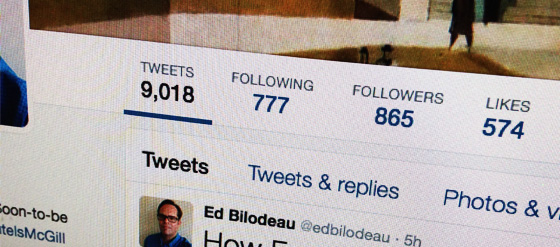Over the past few weeks I’ve been making an effort to shift my use of Twitter over to being a way to reach out and connect with students and faculty studying (or interested in) business and management.
Looking back over my recent tweets, I would say that my initial attempts could be described as Twitter-as-microblog, where I share not only status updates, photos, and links to library resources and news, but links to news articles and other things that I come across that I think might be of interest to my audience.
This approach has been somewhat successful. According to Twitter, all my metrics are up over last month (which I need to remember was a month of being in-between positions and so my efforts on Twitter may have been somewhat lacklustre).
Still, I haven’t been able to shake the feeling that I’ve been / am doing it wrong. It feels too automatic, too habitual, too much like I’m going through the motions. I’m pushing the metrics but I’m not sure that I’m connecting. I don’t want this to just be a feed. I want it to mean something, both to me and to the people that follow me.
With that in mind, I’ve reflected on how I might be able to improve my practice in this area, and have come up with the following guidelines that I’m going to try to keep in mind going forward.
Focus on time. What is happening now? What am I doing? What am I seeing? What have I accomplished? What will be happening in the future?
Avoid sharing news or items of interest. People who want to know what is happening in the world, even what is happening closer to home, have other (far better) ways of finding this out. They don’t need me to cull/curate the daily news stream for them. The exception might be when these things are closely related to me and/or my work. When in doubt, don’t share. (I also know from Twitter’s analytics that these kinds of tweets get very little in the way of engagement.)
This is actually going to be one of the hardest changes to make. I’ve formed a deeply ingrained habit formed over the past 15+ years of scanning news feeds and sharing what I come across. This started with blogging and shifted to Twitter and Facebook. I actually find it hard to scan/read and not share. But I know this is a twitch habit, a pacifier, and that it doesn’t bring all that much value to myself or my readers/followers. Having said that, I do have a few pressure valves that I can use to redirect this habit: pinterest (images) and pinboard (links). And of course there is this blog, but the overhead of writing a blog post is so high that I don’t expect it to happen very often.
Avoid sharing too many links to Library resources. This might sound counter intuitive, but my thinking is if my tweet stream is primarily links promoting library services, resources, and news then it (I) am going to come across as more of a marketing bot than as a real person who is interested in sharing and connecting with others. I can talk about and point to these things as they relate to what I am doing in the moment, but a steady stream of “did you know” and “looking for” and similar links isn’t likely to provide much value to anyone.
Now I know from even a few weeks that I have a lot of work to do to raise awareness and help students learn about the resources and services that the Library has to offer. But dumping these into a Twitter stream isn’t the way to do it. (Worse is that the metrics might make me feel like I am accomplishing something, when in fact I’m not.)
***
These are small changes, easy to understand but possible hard to put into practice. It means changing habits and also changing how I think about Twitter. But I still believe that there is a real potential in using Twitter to connect with my community, so it is an effort that is worth making.



